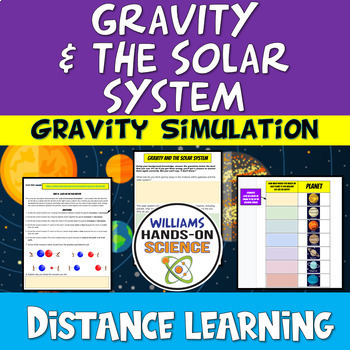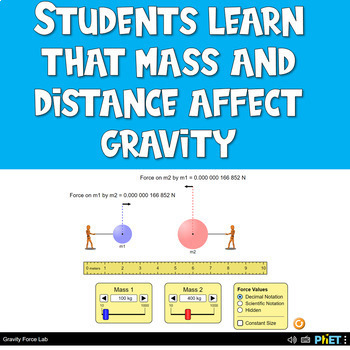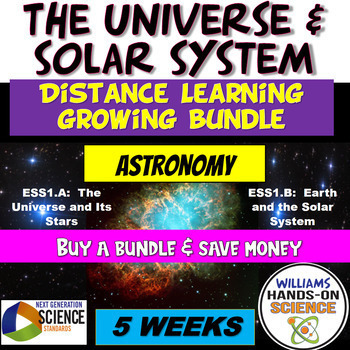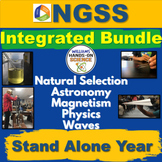Gravity & Solar System NGSS ESS1.A ESS1.B Online Simulation Digital
- Google Slides™

Also included in
- Looking for a complete, standalone year-long curriculum for integrated NGSS Physics, Energy, Waves, Astronomy, Earth’s History, Science and Engineering Practices, Crosscutting Concepts, and Evolution? Look no further than this student-centered, inquiry-based, hands-on bundle! Designed to align withPrice $205.00Original Price $366.00Save $161.00
Description
If you’re teaching NGSS ESS1.B: Earth and the Solar System The solar system consists of the sun and a collection of objects, including planets, their moons, and asteroids that are held in orbit around the sun by its gravitational pull on them (MS-ESS1-2) this is perfect for you! There’s no better way to hit the NGSS Science and Engineering Practice of Developing and Using Models than using PhET simulations! Students will be engaged and challenged by the simulation and questions.
Take a look at this astronomy bundle and save money!
This resource comes with the following:
-Google Ready Student Copy for Distance Learning
-Key
This 45 minute resource contains the following concepts:
-Factors that Affect Gravity
-Law of Universal Gravitation
-Orbit
-The Sun and all the planets
-Solar System
-What you would weigh on each planet
The NGSS Standards included:
NGSS Performance Expectation (PE)
Develop and use a model to describe the role of gravity in the motions within galaxies and the solar system. MS-ESS1-2
Disciplinary Core Ideas (DCI)
ESS1.B: Earth and the Solar System
• The solar system consists of the sun and a collection of objects, including planets, their moons, and asteroids that are held in orbit around the sun by its gravitational pull on them. (MS-ESS1-2) (MS-ESS1-3)
ESS1.A: The Universe and Its Stars
• Earth and its solar system are part of the Milky Way galaxy, which is one of many galaxies in the universe. (MS-ESS1-2)
Science and Engineering Practices (SEP)
Developing and Using Models
A practice of both science and engineering is to use and construct models as helpful tools for representing ideas and explanations. These tools include diagrams, drawings, physical replicas, mathematical representations, analogies, and computer simulations .
Cross Cutting Concepts (CCC)
Patterns
Observed patterns in nature guide organization and classification and prompt questions about relationships and causes underlying them.
Cause & Effect Events have causes, sometimes simple, sometimes multifaceted. Deciphering causal relationships, and the mechanisms by which they are mediated, is a major activity of science and engineering.
Systems and System Models
A system is an organized group of related objects or components; models can be used for understanding and predicting the behavior of systems.
If there are any errors or questions, please contact me through TpT or email me at:
williamshandsonscience@gmail.com
Thank you for taking a look!
Please follow me on TpT for new products and check me out on Instagram for my products in action!
https://www.instagram.com/williamshandsonscience/
⭐ Bill Nye Questions Waves Electromagnetic Spectrum
⭐ Claim Evidence Reasoning (CER): Autumn Equinox Can Fall on Different Days
⭐ ESS1.A & B PS4.A & B ESS2.A NGSS Integrated Scale of Universe Card Sort & Video
⭐ ESS1.A MS-ESS1-2 The Universe & Its Stars Astronomy Activity Scale Space Systems
⭐ ESS3.C NGSS Claim Evidence Reasoning: Climate Change is Bad for Humans
⭐ Earth, Moon and Sun PowerPoint and Guided Notes
⭐ MS-ESS1-1: Oreo Moon Phases Lab NGSS Modeling
⭐ MS-PS1-5: Chemical Reactions Simulation Conservation of Mass Close Reading Notes
⭐ MS-PS4-1 MS-PS4-2 MS-PS4-3 Waves Card Sort, Vocabulary Chart and YouTube Clips
⭐ MS-PS4-3: NGSS Analog Vs. Digital Wave Properties 5E Telephone Lab
⭐ NGSS Astronomy Resource Bundle: PowerPoint Labs Guided Notes Prezi Board Game
⭐ NGSS Analog Digital Card Sort PS4.C Information Technologies & Instrumentation
⭐ NGSS Black Holes & Galaxies Claim Evidence Reasoning Graphic Organizer
⭐ NGSS Claim Evidence Reasoning (CER) Big Bang Graphic Organizer
⭐ NGSS Claim Evidence Reasoning (CER) High Frequency Sound Waves
⭐ NGSS Claim Evidence Reasoning (CER) Water Found on Mars
⭐ NGSS Claim Evidence Reasoning The Mysterious Planet Nine Solar System Astronomy
⭐ NGSS Earth's Orbit Around The Sun Stop Motion Movie
⭐ NGSS Electromagnetic Spectrum Waves Doodle Notes & PowerPoint
⭐ NGSS Expanding Universe Claim Evidence Reasoning Graphic Organizer
⭐ NGSS MS-ESS1-2 MS-ESS1-2 Evidence for Big Bang Theory Online CER Activity
⭐ NGSS Middle School Sound Waves Stations & Close Reading
⭐ NGSS PowerPoint Sound, Light, Digital, Analog, Transverse and Longitudinal Waves
⭐ NGSS Waves Electromagnetic Spectrum Properties Worksheet
⭐ NGSS Waves Light Stations Electromagnetic Phenomena






